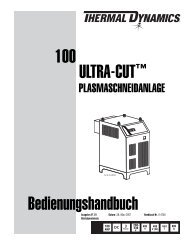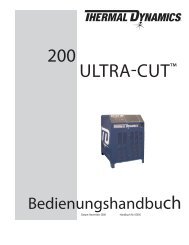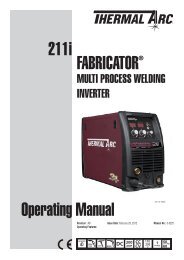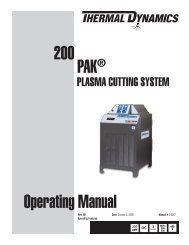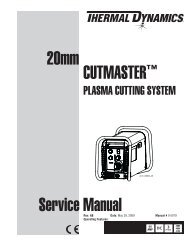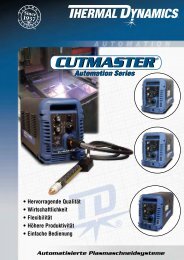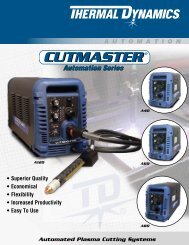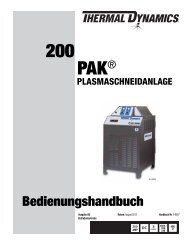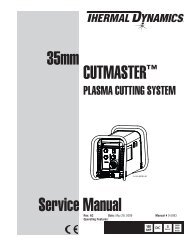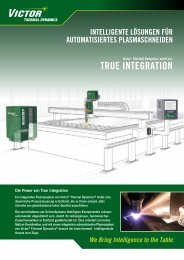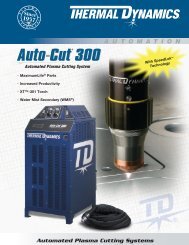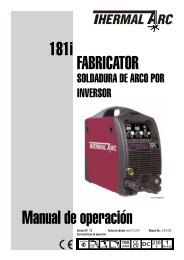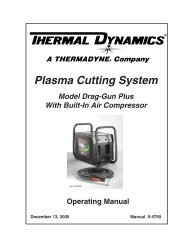DocLib_42_0-4905 ArcMaster 400MST CE.pdf - Victor Technologies ...
DocLib_42_0-4905 ArcMaster 400MST CE.pdf - Victor Technologies ...
DocLib_42_0-4905 ArcMaster 400MST CE.pdf - Victor Technologies ...
You also want an ePaper? Increase the reach of your titles
YUMPU automatically turns print PDFs into web optimized ePapers that Google loves.
HOT START<br />
This parameter operates in STICK mode and improves the start characteristics for stick electrodes. e.g.<br />
low hydrogen electrodes. It sets the peak start current on top of the WELD current.<br />
e.g. HOT START current = 150 amps when Weld Current = 100 amps & HOT START = 50A<br />
WELD (A)<br />
This parameter sets the STICK & Lift TIG weld current.<br />
ARC CONTROL<br />
This parameter operates in STICK mode only and is used to adjust percentage increase in welding<br />
current and is proportional to arc length (arc voltage). This control provides an adjustable amount of<br />
arc control (or dig). This feature can be particularly beneficial in providing the operator with the ability<br />
to compensate for variability in joint fit up in certain situations with particular electrodes, e.g. cellulose<br />
and hydrogen controlled electrodes. In all welding processes, the amount of penetration obtained is<br />
dependent on the welding current; i.e. the greater the penetration, the greater the current.<br />
Arc Force Position Current Increase when Arc<br />
Voltage is less than 18V<br />
25<br />
Effect on Welding Performance<br />
Minimum (0) 0A Soft arc, Low spatter, Low<br />
penetration<br />
Medium (20%) 32A Normal arc, Improved fusion<br />
characteristics,<br />
Normal penetration<br />
Maximum (100%) 160A Hard arc, Deep penetration<br />
Table 5 – Weld Parameter Descriptions<br />
In general, having the ARC CONTROL set at 100% (maximum) allows greater penetration control to<br />
be achieved. With the ARC CONTROL set at 0% (minimum) the Power Source has a constant current<br />
characteristic. In other words, varying the arc length does not significantly affect the welding current.<br />
When the ARC CONTROL set to 100%, it is possible to control the welding current by varying the arc<br />
length. This is very useful for controlling penetration on root runs and side wall wash on vertical up<br />
fillet welds.<br />
Root runs<br />
During root runs the weld pool forms a “keyhole” shape. If too much weld current is<br />
used, the hole blows out and the weld collapses. If too little weld current is used, the<br />
hole closes up and penetration is lost. The size of the hole also determines the arc<br />
length; i.e. as the hole gets bigger, the arc gets longer.<br />
If arc force is used, the increase in the arc length causes the weld current to decrease<br />
until the hole starts to close up but if the hole closes up to much then the arc length<br />
decreases which causes the weld current to increase. Too little or too much arc force<br />
makes this process unstable. The operator must adjust the arc force until a happy<br />
medium is reached.



